Distinct phenotype and function of circulating Vδ1+ and Vδ2+ γδT-cells in acute and chronic hepatitis B
- PMID: 30998783
- PMCID: PMC6490945
- DOI: 10.1371/journal.ppat.1007715
Distinct phenotype and function of circulating Vδ1+ and Vδ2+ γδT-cells in acute and chronic hepatitis B
Abstract
Hepatitis B virus (HBV) persists with global and virus-specific T-cell dysfunction, without T-cell based correlates of outcomes. To determine if γδT-cells are altered in HBV infection relative to clinical status, we examined the frequency, phenotype and function of peripheral blood Vδ1+ and Vδ2+γδT-cells by multi-parameter cytometry in a clinically diverse North American cohort of chronic hepatitis B (CHB), acute hepatitis B (AHB) and uninfected control subjects. We show that circulating γδT-cells were comprised predominantly of CD3hiCD4- Vδ2+γδT-cells with frequencies that were 2-3 fold higher among Asian than non-Asian Americans and inversely correlated with age, but without differences between CHB, AHB and control subjects. However, compared to control subjects, CHB was associated with increased TbethiEomesdim phenotype in Vδ2+γδT-cells whereas AHB was associated with increased TbethiEomesdim phenotype in Vδ1+γδT-cells, with significant correlations between Tbet/Eomes expression in γδT-cells with their expression of NK and T-cell activation and regulatory markers. As for effector functions, IFNγ/TNF responses to phosphoantigens or PMA/Ionomycin in Vδ2+γδT-cells were weaker in AHB but preserved in CHB, without significant differences for Vδ1+γδT-cells. Furthermore, early IFNγ/TNF responses in Vδ2+ γδT-cells to brief PMA/Ionomycin stimulation correlated inversely with serum ALT but not HBV DNA. Accordingly, IFNγ/TNF responses in Vδ2+γδT-cells were weaker in patients with CHB with hepatitis flare compared to those without hepatitis flares, and this functional deficit persisted beyond clinical resolution of CHB flare. We conclude that circulating γδT-cells show distinct activation and differentiatiation in acute and chronic HBV infection as part of lymphoid stress surveillance with potential role in clinical outcomes.
Conflict of interest statement
Anna S. F. Lok has received research grants (to the University of Michigan) from Bristol-Myers Squibb and Gilead, and has served on advisory board of Gilead.
Figures
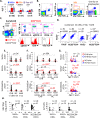
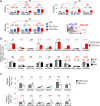
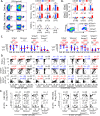

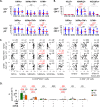
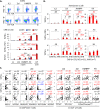
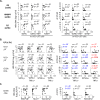
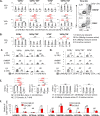
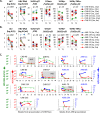
Similar articles
-
Hepatitis B Virus--Specific and Global T-Cell Dysfunction in Chronic Hepatitis B.Gastroenterology. 2016 Mar;150(3):684-695.e5. doi: 10.1053/j.gastro.2015.11.050. Epub 2015 Dec 10. Gastroenterology. 2016. PMID: 26684441 Free PMC article.
-
Increased Frequencies of Circulating IFN-γ-Producing Vδ1(+) and Vδ2(+) γδ T Cells in Patients with Asymptomatic Persistent Hepatitis B Virus Infection.Viral Immunol. 2015 May;28(4):201-8. doi: 10.1089/vim.2014.0133. Epub 2015 Mar 19. Viral Immunol. 2015. PMID: 25789722
-
Unique and Common Features of Innate-Like Human Vδ2+ γδT Cells and Mucosal-Associated Invariant T Cells.Front Immunol. 2018 Apr 23;9:756. doi: 10.3389/fimmu.2018.00756. eCollection 2018. Front Immunol. 2018. PMID: 29740432 Free PMC article.
-
Neuroblastoma killing properties of Vδ2 and Vδ2-negative γδT cells following expansion by artificial antigen-presenting cells.Clin Cancer Res. 2014 Nov 15;20(22):5720-32. doi: 10.1158/1078-0432.CCR-13-3464. Epub 2014 Jun 3. Clin Cancer Res. 2014. PMID: 24893631 Free PMC article.
-
The therapeutic role of γδT cells in TNBC.Front Immunol. 2024 Jun 12;15:1420107. doi: 10.3389/fimmu.2024.1420107. eCollection 2024. Front Immunol. 2024. PMID: 38933280 Free PMC article. Review.
Cited by
-
The Contribution of Human Herpes Viruses to γδ T Cell Mobilisation in Co-Infections.Viruses. 2021 Nov 26;13(12):2372. doi: 10.3390/v13122372. Viruses. 2021. PMID: 34960641 Free PMC article. Review.
-
Highly multiplexed 2-dimensional imaging mass cytometry analysis of HBV-infected liver.JCI Insight. 2021 Apr 8;6(7):e146883. doi: 10.1172/jci.insight.146883. JCI Insight. 2021. PMID: 33621209 Free PMC article.
-
Non-Classical HLA Class 1b and Hepatocellular Carcinoma.Biomedicines. 2023 Jun 9;11(6):1672. doi: 10.3390/biomedicines11061672. Biomedicines. 2023. PMID: 37371767 Free PMC article. Review.
-
Diverse Functions of γδ T Cells in the Progression of Hepatitis B Virus and Hepatitis C Virus Infection.Front Immunol. 2021 Feb 1;11:619872. doi: 10.3389/fimmu.2020.619872. eCollection 2020. Front Immunol. 2021. PMID: 33597951 Free PMC article. Review.
-
Current Best Practice in Hepatitis B Management and Understanding Long-term Prospects for Cure.Gastroenterology. 2023 Jan;164(1):42-60.e6. doi: 10.1053/j.gastro.2022.10.008. Epub 2022 Oct 12. Gastroenterology. 2023. PMID: 36243037 Free PMC article. Review.
References
-
- Ferrari C, Missale G, Boni C, Urbani S. Immunopathogenesis of hepatitis B. Journal of hepatology. 2003;39 Suppl 1:S36–42. Epub 2004/01/08. . - PubMed
Publication types
MeSH terms
Substances
Grants and funding
- UL1 TR001111/TR/NCATS NIH HHS/United States
- UL1 TR000058/TR/NCATS NIH HHS/United States
- U01 DK082867/DK/NIDDK NIH HHS/United States
- I01 BX000649/BX/BLRD VA/United States
- U01 DK082874/DK/NIDDK NIH HHS/United States
- U01 DK082919/DK/NIDDK NIH HHS/United States
- U01 DK082927/DK/NIDDK NIH HHS/United States
- U01 DK082872/DK/NIDDK NIH HHS/United States
- U01 DK082943/DK/NIDDK NIH HHS/United States
- K24 AA022523/AA/NIAAA NIH HHS/United States
- P30 DK050306/DK/NIDDK NIH HHS/United States
- M01 RR000040/RR/NCRR NIH HHS/United States
- R01 AI047519/AI/NIAID NIH HHS/United States
- U01 DK082923/DK/NIDDK NIH HHS/United States
- U01 DK082871/DK/NIDDK NIH HHS/United States
- U01 DK082944/DK/NIDDK NIH HHS/United States
- U01 DK082864/DK/NIDDK NIH HHS/United States
- U01 DK082843/DK/NIDDK NIH HHS/United States
- U01 DK082863/DK/NIDDK NIH HHS/United States
- UL1 TR000004/TR/NCATS NIH HHS/United States
- U01 DK082866/DK/NIDDK NIH HHS/United States
LinkOut - more resources
Full Text Sources
Research Materials

